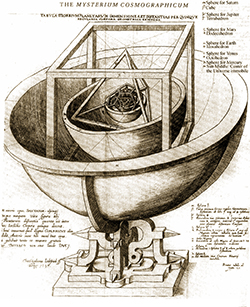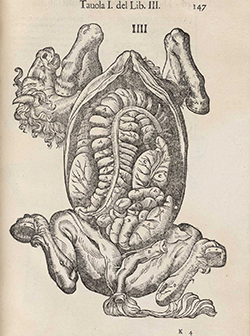MENU
The Electronic Scholarly Publishing Project: Providing access to classic scientific papers and other scholarly materials, since 1993. More About: ESP | OUR CONTENT | THIS WEBSITE | WHAT'S NEW | WHAT'S HOT
Comparative Timelines
The ESP Timeline (one of the site's most popular features) has been completely updated to allow the user to select (using the timeline controls above each column) different topics for the left and right sides of the display.
Select:
New Left Column
New Left Column
Dates
Decade
New Right Column
New Right Column
José de Acosta publishes Natural and Moral History of the Indies describing such weird creatures as iguanas.
Glass lenses are developed in the Netherlands and used for the first time in microscopes and telescopes.
1590
At the Siege of Odawara the Go-Hojo clan surrendered to Toyotomi Hideyoshi, unifying Japan.
Girolamo Porro produces a plan for a botanical garden at Padua, arguably expecting to assemble all the world's plants. Over the next century, well- traveled naturalists will abandon such goals as unrealistic.
 François Viète publishes In Artem Analyticem Isagoge, introducing the new algebra with innovative use of letters as parameters in equations.
François Viète publishes In Artem Analyticem Isagoge, introducing the new algebra with innovative use of letters as parameters in equations.
1591
(no entry for this year)
(no entry for this year)
1592
(no entry for this year)
(no entry for this year)
1593
(no entry for this year)
The tulip bulbs planted by Carolus Clusius in the Hortus Botanicus Leiden, Holland, first flower.
Francis Bacon pens Gesta Grayorum, a staged debate related to science.
Bevis Bulmer sets up a system at Blackfriars, London, for pumping a public water supply.
1594
(no entry for this year)
 Bartholomaeus Pitiscus publishes Trigonometria: sive de solutione triangulorum tractatus brevis et perspicuus in Heidelberg, introducing the term trigonometry to Western European languages.
Bartholomaeus Pitiscus publishes Trigonometria: sive de solutione triangulorum tractatus brevis et perspicuus in Heidelberg, introducing the term trigonometry to Western European languages.
1595
A Spanish expedition led by lvaro de Menda a de Neira makes the first European landing in Polynesia, on the Marquesas Islands.
 Johannes Kepler's Mysterium Cosmographicum is the first published defense of the Copernican (heliocentric) system of planetary motion. This book explains Kepler's cosmological theory, based on the Copernican system, in which the five Pythagorean regular polyhedra dictate the structure of the universe and reflect God's plan through geometry. This was the first attempt since Copernicus to say that the theory of heliocentrism is physically true.
Johannes Kepler's Mysterium Cosmographicum is the first published defense of the Copernican (heliocentric) system of planetary motion. This book explains Kepler's cosmological theory, based on the Copernican system, in which the five Pythagorean regular polyhedra dictate the structure of the universe and reflect God's plan through geometry. This was the first attempt since Copernicus to say that the theory of heliocentrism is physically true.
 Abraham Ortelius, in the last edition of his Thesaurus geographicus, considers the possibility of continental drift.
Abraham Ortelius, in the last edition of his Thesaurus geographicus, considers the possibility of continental drift.
1596
(no entry for this year)
 Andreas Libavius's chemistry textbook Alchemia published. Libavius was a staunch believer in chrysopoeia, or the ability to transmute a base metal into gold. This viewpoint was a matter of much debate for alchemists of the time and he defended it in several of his writings. Though he did discover several new chemical processes, he tended to be more of a theoretician and he leaned toward traditional Aristotelianism rather than Paracelsian alchemy.
Andreas Libavius's chemistry textbook Alchemia published. Libavius was a staunch believer in chrysopoeia, or the ability to transmute a base metal into gold. This viewpoint was a matter of much debate for alchemists of the time and he defended it in several of his writings. Though he did discover several new chemical processes, he tended to be more of a theoretician and he leaned toward traditional Aristotelianism rather than Paracelsian alchemy.
1597
(no entry for this year)
 Tycho Brahe's star catalogue Astronomiae instauratae mechanica, listing the positions of 1,004 stars, is published.
Tycho Brahe's star catalogue Astronomiae instauratae mechanica, listing the positions of 1,004 stars, is published.
Jean Bauhin, a former student of Conrad Gesner's, publishes a monograph of the medicinal waters and surrounding environment of the German fountains at Boll, the first publication of a complete set of fossils from a specific location.
 After being separated from the main Second Dutch Expedition to Indonesia fleet of Admiral Wybrand Van Warwyck, three ships under Jacob Cornelisz. van Neck land on the island which they name Mauritius and sight the dodo bird (Raphus cucullatus); it will become extinct around 1681.
After being separated from the main Second Dutch Expedition to Indonesia fleet of Admiral Wybrand Van Warwyck, three ships under Jacob Cornelisz. van Neck land on the island which they name Mauritius and sight the dodo bird (Raphus cucullatus); it will become extinct around 1681.
1598
(no entry for this year)
 Lawyer Carlo Ruini's Anatomia del cavallo is published posthumously in Venice. This anatomy of the horse is the first published of any non-human animal.
Lawyer Carlo Ruini's Anatomia del cavallo is published posthumously in Venice. This anatomy of the horse is the first published of any non-human animal.
 Ferrante Imperato publishes Dell'Historia Naturale (Natural History) attempting to catalog all of nature's animal, vegetable and mineral forms. He illustrated the book with his own cabinet of curiosities displayed at Palazzo Gravina in Naples. The engraving became the first pictorial representation of a Renaissance humanist's displayed natural history research collection.
Ferrante Imperato publishes Dell'Historia Naturale (Natural History) attempting to catalog all of nature's animal, vegetable and mineral forms. He illustrated the book with his own cabinet of curiosities displayed at Palazzo Gravina in Naples. The engraving became the first pictorial representation of a Renaissance humanist's displayed natural history research collection.
1599
(no entry for this year)
ESP Quick Facts
ESP Origins
In the early 1990's, Robert Robbins was a faculty member at Johns Hopkins, where he directed the informatics core of GDB — the human gene-mapping database of the international human genome project. To share papers with colleagues around the world, he set up a small paper-sharing section on his personal web page. This small project evolved into The Electronic Scholarly Publishing Project.
ESP Support
In 1995, Robbins became the VP/IT of the Fred Hutchinson Cancer Research Center in Seattle, WA. Soon after arriving in Seattle, Robbins secured funding, through the ELSI component of the US Human Genome Project, to create the original ESP.ORG web site, with the formal goal of providing free, world-wide access to the literature of classical genetics.
ESP Rationale
Although the methods of molecular biology can seem almost magical to the uninitiated, the original techniques of classical genetics are readily appreciated by one and all: cross individuals that differ in some inherited trait, collect all of the progeny, score their attributes, and propose mechanisms to explain the patterns of inheritance observed.
ESP Goal
In reading the early works of classical genetics, one is drawn, almost inexorably, into ever more complex models, until molecular explanations begin to seem both necessary and natural. At that point, the tools for understanding genome research are at hand. Assisting readers reach this point was the original goal of The Electronic Scholarly Publishing Project.
ESP Usage
Usage of the site grew rapidly and has remained high. Faculty began to use the site for their assigned readings. Other on-line publishers, ranging from The New York Times to Nature referenced ESP materials in their own publications. Nobel laureates (e.g., Joshua Lederberg) regularly used the site and even wrote to suggest changes and improvements.
ESP Content
When the site began, no journals were making their early content available in digital format. As a result, ESP was obliged to digitize classic literature before it could be made available. For many important papers — such as Mendel's original paper or the first genetic map — ESP had to produce entirely new typeset versions of the works, if they were to be available in a high-quality format.
ESP Help
Early support from the DOE component of the Human Genome Project was critically important for getting the ESP project on a firm foundation. Since that funding ended (nearly 20 years ago), the project has been operated as a purely volunteer effort. Anyone wishing to assist in these efforts should send an email to Robbins.
ESP Plans
With the development of methods for adding typeset side notes to PDF files, the ESP project now plans to add annotated versions of some classical papers to its holdings. We also plan to add new reference and pedagogical material. We have already started providing regularly updated, comprehensive bibliographies to the ESP.ORG site.
ESP Picks from Around the Web (updated 06 MAR 2017 )
Old Science

Weird Science

Treating Disease with Fecal Transplantation
Fossils of miniature humans (hobbits) discovered in Indonesia

Dinosaur tail, complete with feathers, found preserved in amber.
Astronomy

Mysterious fast radio burst (FRB) detected in the distant universe.